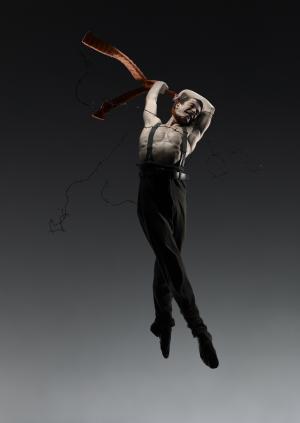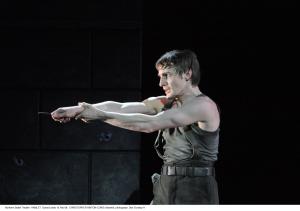Hamlet (2008)
Northern Ballet Theatre
Duration 100’
Ballet in 2 Acts for full orchestra
Choreographed and Directed by David Nixon
Scenario: David Nixon and Patricia Doyle
Design: Christopher Giles
Lighting design: Tim Mitchell
Sound design: Philip Feeney and Chris Colling
Original Cast: Christopher Hinton-Lewis (Hamlet), Nathalie Leger (Gertrude), Georgina May (Ophelia) Darren Goldsmith (Claudius),
First performed at the Grand Theatre, Leeds, in February 2008 by the Northern Ballet Sinfonia, conducted by John Pryce-Jones.
Philip Feeney was approached by Northern Ballet Theatre to write a score for David Nixon’s production of Hamlet in the summer of 2006. With the slight rescheduling of the premiere, the majority of the composition of the score took place in the summer and autumn of 2007. This meant that most of Act 1 was composed in Ireland where the composer was working with Fabulous Beast on Michael Keegan-Dolan’s James, Son of James. One draft of the act 1 party scene in Hamlet was composed in a cottage in rainy County Kerry. Indeed, our neighbours complained at the noise they could hear through the walls, and I fear it was the music’s quality rather than its volume that upset them; it was an early draft, after all. Everyone’s a critic!
David Nixon prepared a synopsis with Pat Doyle that reset Shakespeare’s Hamlet in Nazi-occupied Paris. This provided an exciting new perspective on the traditional narrative, and gave Hamlet’s internal angst a specific modern historical context. It also dealt with the issue that Hamlet is ultimately a play about inactivity, about blocked indecision, and is articulated, perhaps more than any other of Shakespeare’s work, in language. By placing the narrative in a setting, which contains a built-in powerful dramatic tension, Nixon was able to explore the psychological depths of his four main characters in movement. It also created a fertile bed for an emotionally gripping musical score.
In the score, the composer makes good use of sound effects to help set the location and create the claustrophobic atmosphere of occupied Paris. Train whistles, car horns, and sounds that are directly associated with war, such as stormtroopers and machine gun flak, are all present, but are always integrated into the texture of the music. So while it isn’t one of Feeney’s more complex scores as far as the sound goes, (there is no hardware sampler for example), the audio contribution is quite extensive, and requires pinpoint cueing from the keyboard player in the pit.
The Parisian war-torn world of the 1940s is reinforced by the inclusion of songs from the period; In fact we’re actually talking about one song, Auf Dem Dach Der Welt by Marika Rokk, with its clear tango feel in the verse used to great effect in the aforementioned party scene, and the bouncey march-like chorus of the song worked well for the dinner scene in Act 1. In both cases, they start out as something musically alien, quite outside the musical parameters of the rest of the score, only for them to become fully integrated into it.
For much of the score, the character of Hamlet, his voice if you like, is portrayed by the intimate sonority of a solo violin, originally played by Geoff Allen. In this way it was possible to distinguish between the internal workings of Hamlet’s mind (solo violin) and the public actions of the man (the full section of violins). There is also a prominent part for the saxophone, and for the percussion in general, in particular for the snare drum with its strong military associations and its whiff of gunfire.
The music in the ballet is predominantly tense, with only the occasional let up, as in the tender but interrupted pas de deux between Hamlet and Ophelia. In fact the protagonist’s relationship with the two main female characters in the story proves to be crucial to this ballet, more so, one might say, than in the original Shakespeare play. In particular, the intense duet between Hamlet and his mother in Act 2 is at the emotional heart of the ballet, Nixon’s powerful choreography being remorselessly driven by the music towards the quiet but empty reconciliation at the end of the scene.
In rehearsal the lonely unison melody that starts the very delicately scored solo which portrays Ophelia’s Act 2 “goodnight-sweet-ladies” scene scored for a mixture of harp, high piano and glockenspiel (in lieu of crotales) just didn’t sound right. By a process of elimination, Northern Ballet Sinfonia conductor, John Pryce-Jones, was able to discover that it was the harp, quite amazingly, that was unbalancing the fragile texture. We removed the harp, but only from those bars; for the rest of the scene it features significantly, playing an unbearably poignant childlike accompaniment figure.
In a production week, time in the auditorium is at a premium, and this production was no exception. The only ‘quiet time’ to sound check the additional audio was late on a Saturday night. Much good work was done, with the only problem being that the Grand Theatre in Leeds is situated next to a busy night club, which made some of the mixing a little difficult. We weren’t sure if the sound was evoking occupied Paris or a Saturday night in Leeds!
Christopher Hinton-Lewis as Hamlet, photos courtesy of Northern Ballet.


